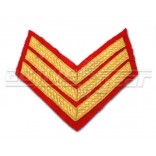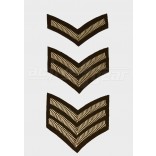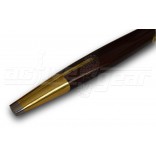Details
SASHES
A sash (Arabic: shash) is a cloth belt used to hold a robe together, and is usually tied about the waist. Decorative sashes may pass from the shoulder to the hip rather than around the waist. Sash is an Arabic loanword that was introduced into the English language in 1590. In Latin America and some countries of Africa, a special presidential sash indicates a president's authority. Most of the European Royal families wear sashes as a part of their royal (and/or military) regalia (the privileges and the insignia characteristic of a Sovereign).
The first mention of infantry sergeant's sash with a single stripe of facing colour in the British Army came in the clothing regulations of 1727. Regulations were vague on whether it was to be worn over the shoulder or around the waist. This was clarified in 1747 when orders were issued calling for sergeants to always wear their sashes around their waists. With the exception of highland regiments, from this point until 1826, the sergeant's sash changed very little.
However there were deviations from regulations from time to time. Until 1914 sashes were worn as a peace-time mark of rank by officers of the Imperial German, Austro-Hungarian and Russian armies, amongst others. Japanese officers continued the practice in full dress uniform until 1940. Today, infantry senior NCOs wears their sashes mainly for regimental duties such as parades and duty.
The purpose was twofold, it made the officers and sergeants distinctive in the smoke and fog of war, but it also acted as litter when wounded and (in the case of officers) as a shroud. By 1881 all were scarlet and the only change was moving the sash to and fro between shoulder and waist at various periods of time. When khaki SD was first introduced the sash was not worn because it was an undress field uniform, but in an effort to dress up the drab uniform for parade in the 1920s permission was granted for the sash to be worn again. Officers however, continued only to wear the sash with best uniform and that is still the case today, when it is only worn with No1 Dress Ceremonial around the waist.
However, in the Caribbean the red wool sash with tassels is for sergeants and Warrant Officers Class Two. It runs from the right shoulder to the waist on the other side. It comes in different regulation sizes depending on the height of persons ranging from size 1 (58 inches/147cm), size 2 (60inches/152cm) to size 3 (62 inches/157cm). The officer’s sash is worn around the waist and manufacturers make the one size adjustable from 38inches to 44inches. Point to note that the Warrant Officer Class One wears a waist sash like the officers. Interestingly, Trinidad and Tobago Air Guard’s sergeant wears a sky blue sash just like the Royal Air Force in the British Army. The red sash is only worn with the Ceremonial Dress and Parade Dress for sergeants and Warrant Officers Class Two and navy blue sash with tassels around the waist for the Ceremonial dress for officers and Warrant Officer Class One. Remember now that each military and cadet force has their own uniforms and different ways of accessorizing them.
Drum Major sash
The origin of the Drum Major's Sash goes back to the ancient battlefield role of a military drummer; in particular, the senior drummer or "Sergeant Drummer". The Sergeant Drummer had a leather carrying sling for the drum which featured loops of either cloth or metal (as seen in the photo on right) to hold the drumsticks when not in use.
In the nineteenth century, the appointment of Drum Major was established. It was at this time the Sergeant Drummer's carrying sling was retained to mark the appointment and started becoming more elaborate. Devices, livery and achievements were affixed to the sling until it become more ceremonial than functional. Cross-belts resembling sashes are worn by Drum Majors in the Dutch, British and some Commonwealth armies. These carry scrolls bearing the names of battle honours. Today, sashes worn by drum majors of military bands are walking museums of regimental history. Still featured on every proper sash are the drumsticks, now in miniature, mounted upon a shield or casing the crest on each side.
Warrant Officer and Sergeant Rank Sashes
Approved warrant officer and sergeant shoulder rank sashes are authorized for wear with Royal Military College (RMC), infantry, and air force ceremonial orders of dress at all times, and with No. 2B mess service dress and No. 3 service orders while on unit duty in accordance with environmental and regimental policy.
The shoulder sash is worn from the right shoulder falling off the left hip, unless worn in conjunction with a Scottish broad sword shoulder belt, when it is worn from the left shoulder falling to the right. Sashes are worn over trouser and waist belts, and over greatcoats and topcoats (gabardines) when a waist belt is also worn overall as a ceremonial accoutrement.
Additional Information
| size | No |
|---|
You may also be interested in the following product(s)
-

Ceremonial Chevrons
$5.00 -

Chevrons- Embroidered
$2.99 -

Pace Stick
$189.99



